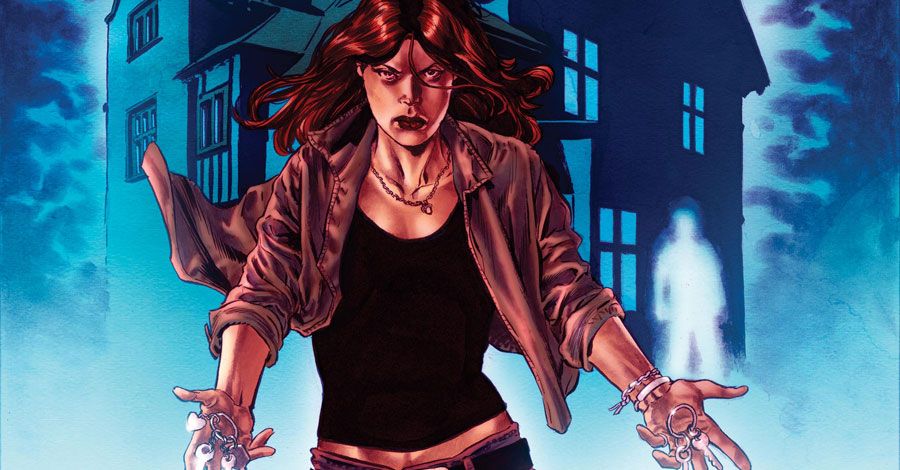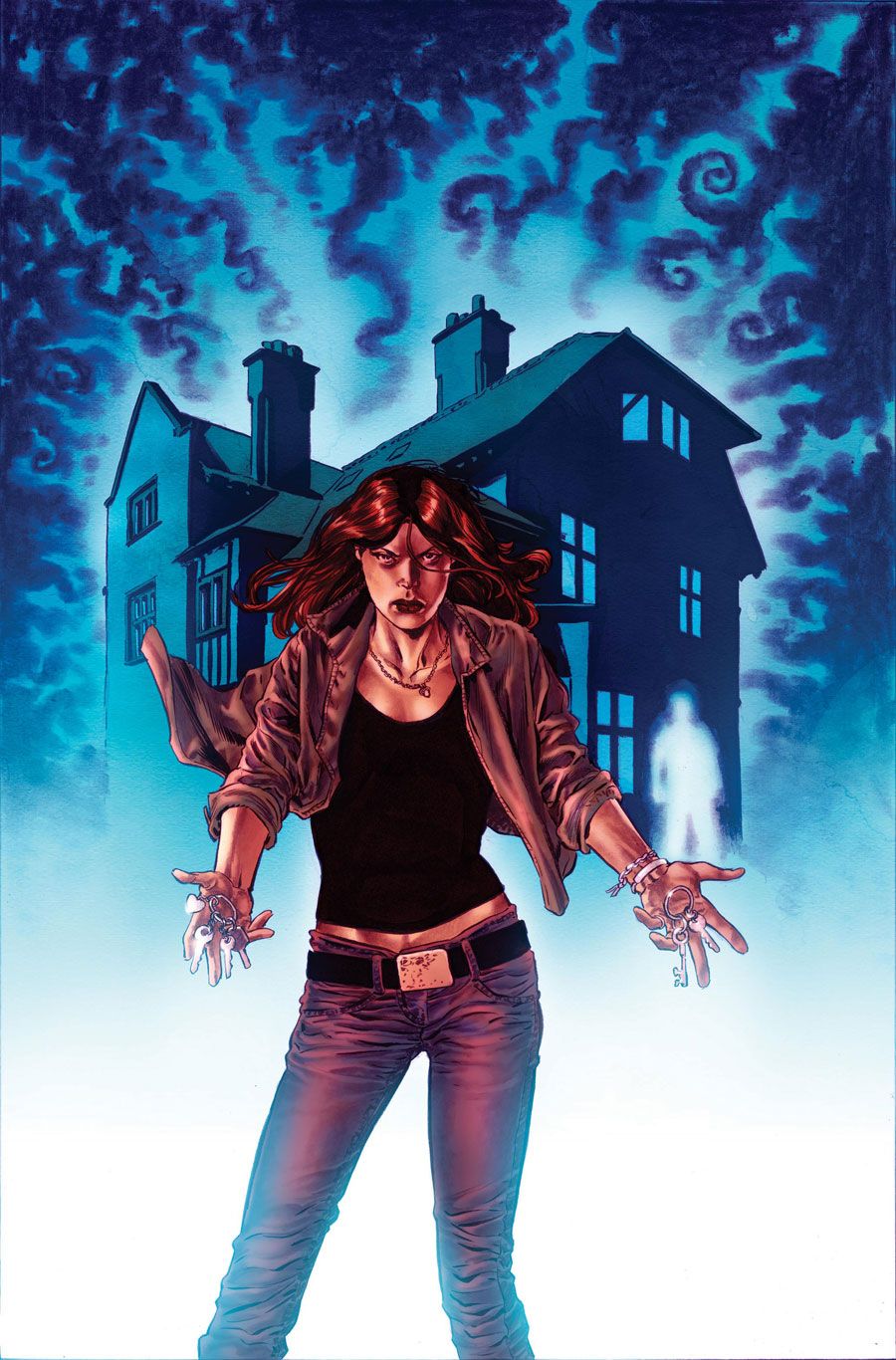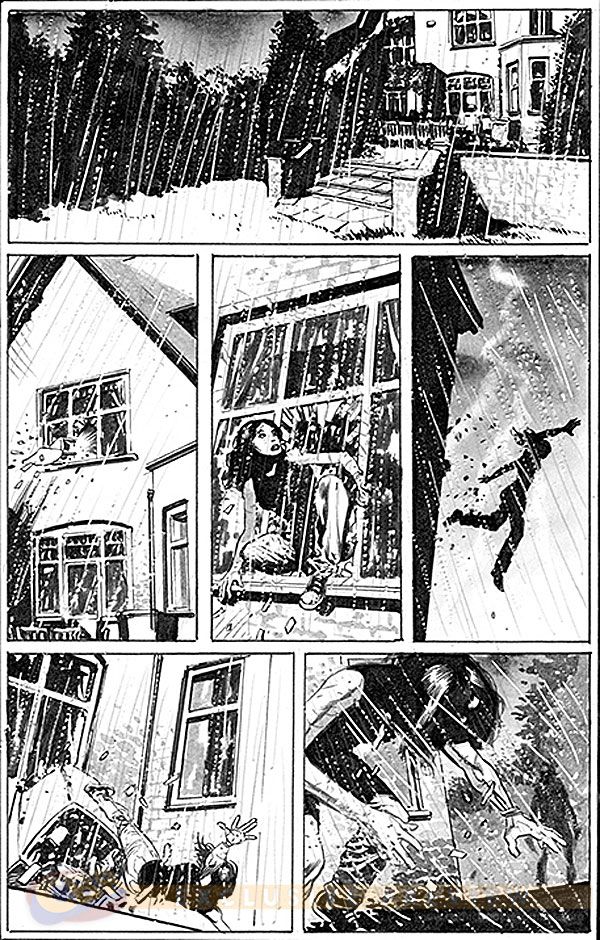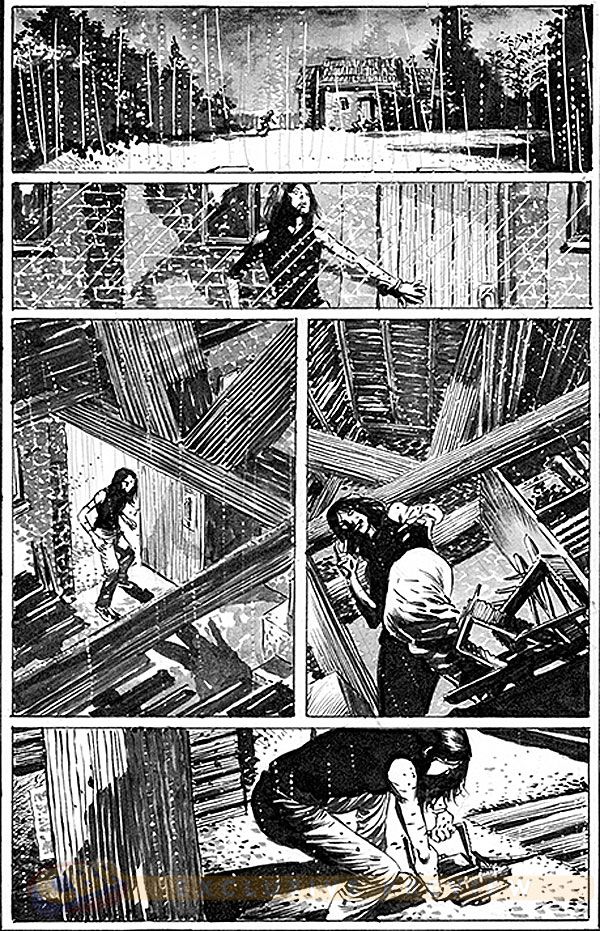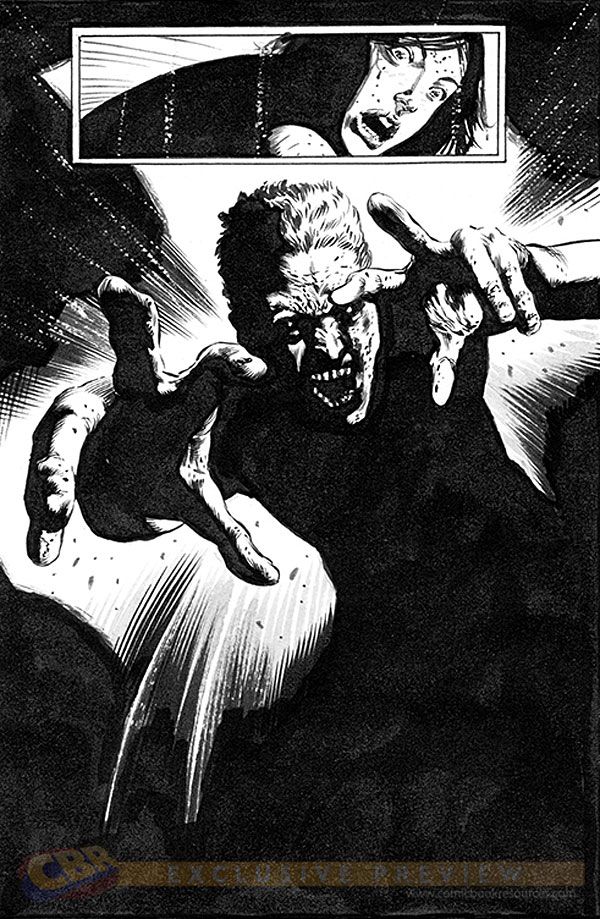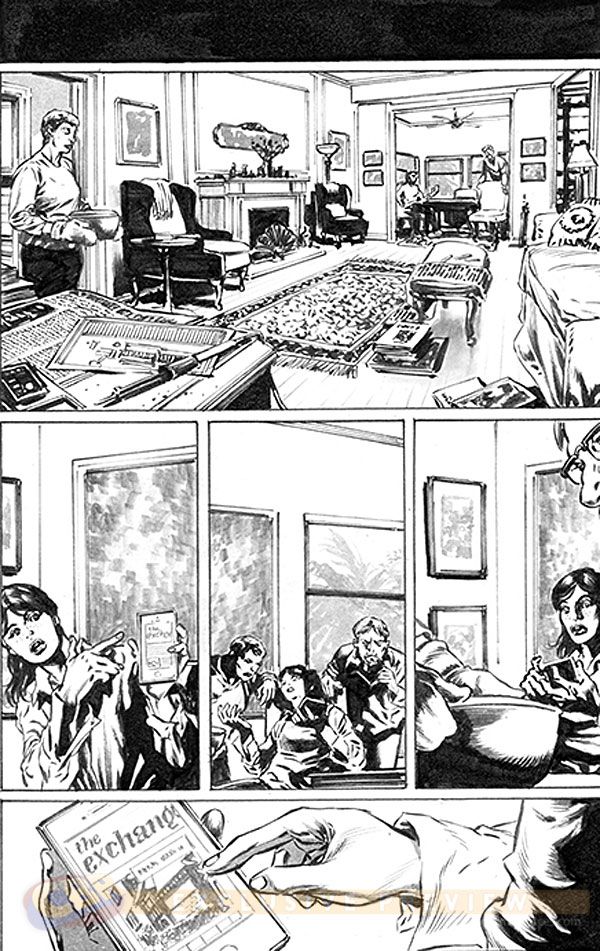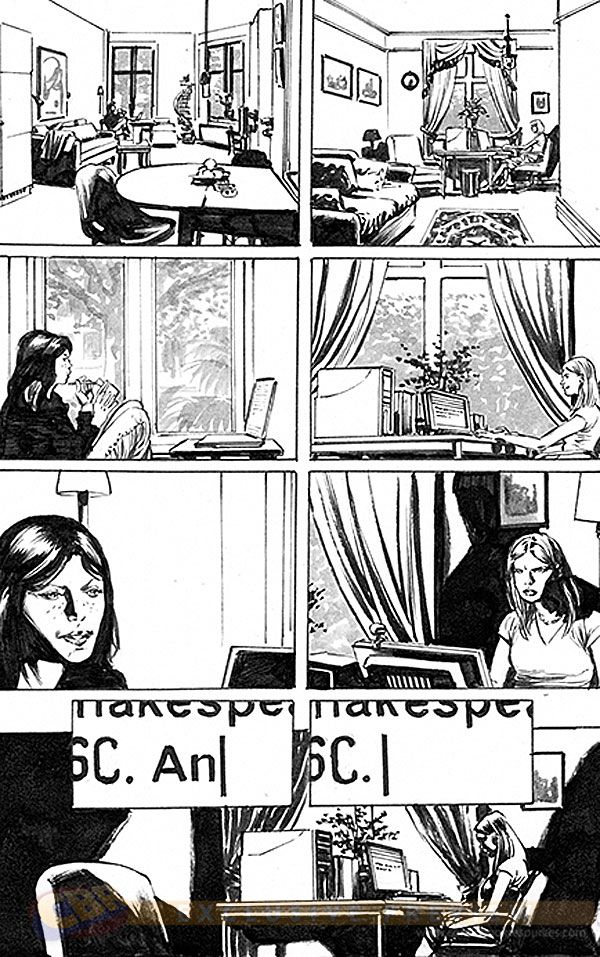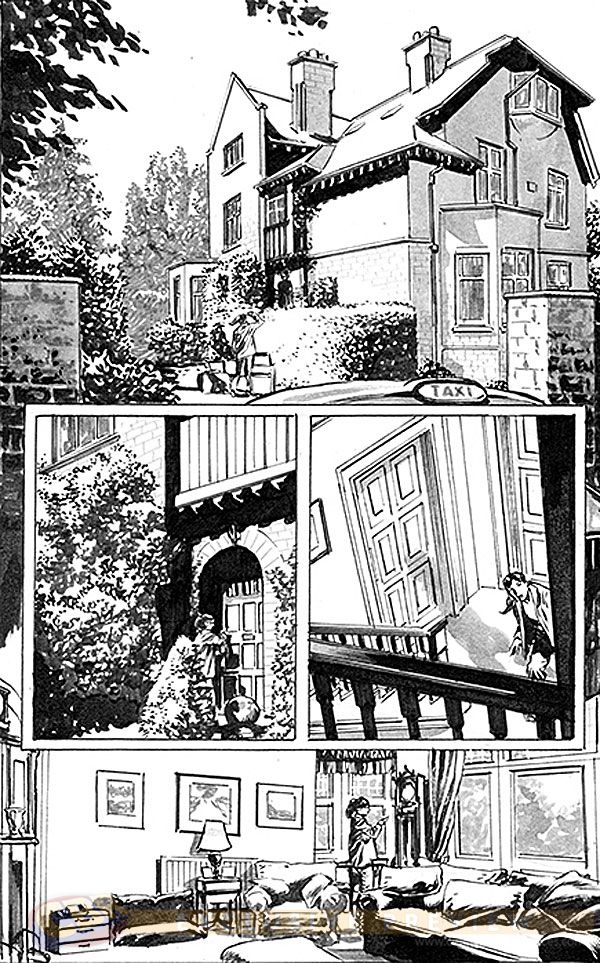Sometimes, you need to completely change your surroundings to get a new perspective on everything. That's Katie's plan as she sets up a house swap that will take her away from her complicated life in Florida and deposit her in the British house called Rowans Rise, inhabited by another young woman named Emily.
That's the basic story of writer Mike Carey and artist Mike Perkins' October 7-launching "Rowans Ruin," but there's far more to the 4-issue BOOM! Studios title than that. At first, Katie enjoys her change of venue, but soon she realizes that the house is not the idyllic, peaceful place she had assumed it was. In fact, it's giving her terrible nightmares, reminding her of her own troubled past.
Inspired by films like "The Conjuring" and "Silent House," "Rowans Ruin" finds its heroine uncovering some dark secrets that spur her on to further exploration. And when Katie turns to the local librarian and a policeman to find the truth, she learns that not everyone -- or everything -- thinks these secrets need uncovering.
CBR News: When you're working on a story like this that revolves around a specific location like Rowans Rise, do you design a model of exactly how the house looks, almost like a blueprint?
Mike Carey: In this case, we did. Mike is working directly from floor plans of the actual house that is our model. We're both sold on the importance of getting real-world geography right where possible. It's good for the fantasy elements in a story like this to be grounded in some sense of a real place with a credible internal logic.
And, in a more general sense, this is a story where location matters. It's a tale of the West Country in the UK, an area with a very rich folklore and a huge sense of its own history. We've tried to weave that into the narrative, to give a sense of the weight of the past in the house and the area around it.
Mike Perkins: I have a pretty strong idea of the look of Rowans Rise, as its lines and angles are based upon a real house. The floor plan is pretty much the same -- with some minor alterations -- so that we have a sense of place and setting when figuring out our scenes. I believe this commitment to the sense of realism to the setting helps to centre the reader within the story and will lead to a growing feeling of unease as the story progresses.
What can you tell us about Katie and the process of building her as a character? She sounds brave to go on a trip like this, and maybe a little too curious for her own good.
Carey: She has a lot of exuberance and fearlessness. She's resourceful, good-hearted, intelligent -- a very relatable heroine. But she's not just a list of virtues. She's had a troubled childhood in some ways, although she wears it lightly. She has a kind of sensitivity, a heightened awareness of the emotional history of the places she's in. And she's experienced some traumas as a result of that. But nothing like what's waiting for her at Rowans Rise.
And yeah, she does barge into things without thinking sometimes. Gets in too deep. Fearlessness is a double-edged sword.
Perkins: She's definitely looking for adventure. A chance to spread her wings a little away from the confines of her loving family. I think she gets so caught up in the fact that she's lucky enough to be swapping her tiny apartment for a massive house in England that the momentum of this pushes away any niggling worries -- at least to begin with.
Does she meet any other characters in England who either help or hinder her as she digs into the history of Rowans Rise?

Carey: She meets a young police constable, James Hallam, who knows a fair bit about the recent history of the house. He's a big help to her at some points -- but not always, and not unconditionally. And she makes friends with the local librarian, who also turns out to have a personal link to Rowans Rise and some of its former residents.
The most important source of information is Emily, the girl she's swapped with and who was at ground zero for some of the earlier happenings at the house. But Emily doesn't seem to want to talk about it -- and given the tragic nature of some of what she's experienced, Katie can't press too hard. So she has to resort to other methods to fill in some of the gaps in her knowledge -- and that's when she maybe makes some bad decisions.
Perkins: James, a handsome, young policeman, seems to be stepping in as the gallant prince -- but this isn't that kind of story.

What made the owners of the house so nefarious?

Carey: It's hard to talk about that side of the story without giving away some of how the story works. The Rise has always been a place where dark and unsettling stuff has happened. There are bird bones -- wards against evil magic -- set in the mortar between its bricks. But in recent years the family that lives there, Emily's family, has been targeted in some overtly violent and hostile ways that may or may not relate to the older phenomena. What Katie mainly has to go on is her sixth sense for emotional residues. She's sensing something that feels trapped in the house, enclosed, hemmed in. She sets out to find what that something might be.
Perkins: I have a whole history of the house tucked away in the back of my mind, and it's something I'd like to play around with in the future, given the opportunity to do so.

The story is set in England, where it feels like there's a lot more history around every corner compared to the United States. Was that a specific element you wanted to work with in the story?

Perkins: Definitely. I live in Florida now, and it's for sure one of the things that really hits me when I go back to England to visit -- simply that sense of history at every turn. Stratford-upon-Avon itself is a town that's not so big -- within a 5-mile radius, you have five houses that Shakespeare is associated with as well as the Royal Shakespeare Company theatre. He actually walked those streets -- he may have been inspired by "Rowans Rise" when he was a child. Katie is aware and enamored by those facts and possibilities, but that history plays into the bricks and mortar of a city, and that history can be, well, blood-curdling.
Carey: It certainly gave us a lot to work with! When a town has been a settlement for more than a thousand years you can fit in -- or at least allude to -- a lot of backstory. There's room for history to have repeated itself a great many times. Which means that your narrative present feels like a small stage with an immense backdrop. It's a cool effect to play with.
You two worked together previously on "Spellbinders," another supernatural story. Did that earlier work directly lead into this one?
Carey: Not directly, no. Actually, "Spellbinders" had a fairly complicated genesis. It started out as Mike and me trying to re-invent a classic Marvel super-villain team -- Salem's Seven -- and then creating a new set of characters instead. So we were referencing a fairly specific type of magic in that book -- the type that's at home in a superhero milieu.
"Rowans Ruin" is a chiller in a classic mold. A haunted house story with its roots more in cinema traditions than anything else. But I guess you can look at the two series and get a sense of where our comfort zone is. There is definitely something that draws us to supernatural stories.
Perkins: We've actually worked on quite a few projects together, pretty much from the outset of our respective careers, and have always enjoyed it immensely. We seem to push each other and collaborate well. This working process goes from "Doctor Faustus" for Caliber, through "Carver Hale" for 2000AD, followed by "Spellbinders," then a few Marvel Christmas short stories and then "Thor: Wolves of The North." It's undoubtedly true that we veer more towards the supernatural side of things -- but therein lies the mystery, intrigue and depth that ensures an interesting, riveting tale.
What challenges does working on a suspense story like this offer in the comics medium? You can't rely on some of the conventions we're used to when that subgenre is presented in film.
Carey: No you can't, that's true -- but you can rely on your readers bringing a knowledge of those cinematic tropes with them into the story, so you can play off them in various ways. A lot of the vocabulary of horror is universal. It's about the timing of reveals, the build-up and the false pay-off, the winding-up of tension, the red herrings that coax you to look the wrong way as the axe is about to fall.
I write in a full-script format, which nominally puts me in control of the pace and the page turns. But with Mike, there's a much more democratic process going on. He has carte blanche to deviate from the script when he sees an opportunity to set up a cool beat or an unsettling effect. The art builds atmosphere all by itself, of course. Mike is brilliant at chiaroscuro and at using page layout to delay a reveal.
The important thing, I think, is to keep the story taut. You can't constantly be on the edge of your seat for 80-plus pages, but any release of tension has to be followed pretty quickly by a new jolt or reveal, a new build-up. We've also played a lot of games with point of view. There are a number of times when the reader is seeing things that the characters are unaware of.
Perkins: It's definitely trickier to portray suspenseful horror in a comic as we can't rely on the backdrop of an orchestra of strings. What we have to do is show that tension through lighting and viewpoint.
You mentioned the inspiration from film, were there any particular horror movies or comics that helped inspire you to tackle this particular project?
Perkins: Not overtly, although there are many great projects out there -- such as "Pandemonium" by Christophe Bec and Stefano Raffaele, or "Sudden Gravity (A Tale of the Panoptican)" by Greg Ruth -- that provide the requisite atmosphere. What really helped to inspire the story was that I had a house swap of my own and, although it was nowhere near as terrifying as the one we represent, it did set the wheels of imagination rolling.
Carey: We've both got our favorite reference points, of course. "Silent House" and "The House At the End of Time" are two of mine, just for the powerful claustrophobic vibe they generate. "The Shining" is another, because of its brilliant use of space. And I guess I'd add the more recent indie horror "It Follows," for the way it uses floating camera effects.
"Rowans Ruin" #1 from Mike Carey, Mike Perkins and BOOM! Studios skulks into stores on October 7.

